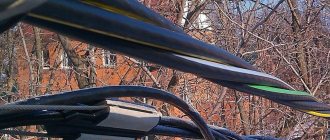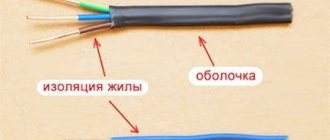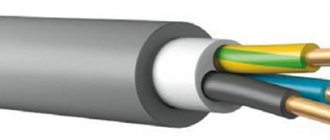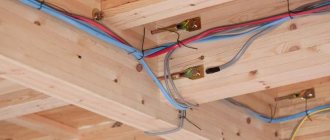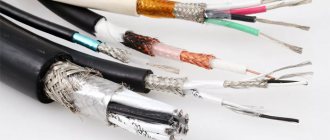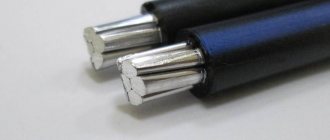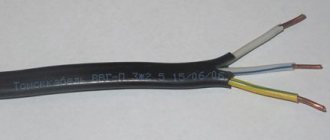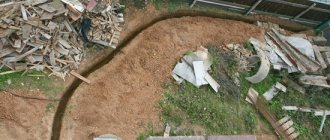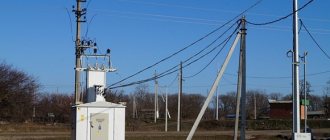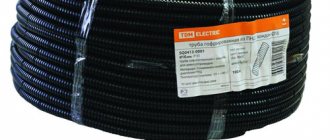To provide lamps and equipment on the site with electricity, a separate branch is laid from the house along the street. However, not every wire is suitable for this, due to the specific factors affecting it - heat, cold, wind, precipitation, sunlight, soil pressure. Therefore, we will consider which cable to use for wiring outdoors through the air and in the ground, what are its features and the requirements for it, what types there are, what markings are applied to them, as well as what are the main options and rules for their installation.
Universal NYY cable for outdoor wiring Source alicdn.com
Outdoor cable - what is it, features, requirements
To ensure reliability, safety and durability of the external electrical network, a cable is used instead of a conventional conductor. Its main features are as follows:
- The design is an assembly of several cores (usually from 2 to 4), covered with an individual insulating sheath and a common outer one.
- The insulating coating can have several layers of different materials - rubber, polyethylene, PVC, metal.
- Multilayer insulation provides reliable protection of the structure from external destructive factors, thanks to which the network can be carried out not only through the air, but also in soil and water.
- The sheath can significantly strengthen the cable, even giving it armored properties.
Power cable with a metal armored shell Source zvetlit.ru
Unlike a cable, a wire for street electrical wiring is a single metal wiring. It may be covered with an insulating coating or bare. Moreover, in both cases, the cores can have a monolithic or multi-hair structure. The latter option is more resistant to mechanical damage and almost never breaks down due to all kinds of kinks during installation and operation.
Requirements
When laying a cable along the street, it is necessary to take into account the negative factors affecting it - these are:
- Temperature changes. Under the influence of heat in summer, the insulating shell softens, and in winter, on the contrary, it hardens. To avoid destruction under the influence of this type of influence, the insulation material must have sufficient resistance for this - be both elastic and durable.
- Wind load. The stronger the wind, the more the cable will be subject to tearing and stretching. Therefore, its structure must include elements and materials that can withstand this kind of element.
The cable must have a reliable fastening and withstand strong wind loads Source bazar2000.ru
- Ultra-violet rays. Direct solar radiation contributes to the structural destruction of the wire sheath. Without special properties, the insulation will become brittle over time, while other factors (wind and temperature) will accelerate these processes.
Note! A cable for outdoor installation can have both copper and aluminum conductors. The former are significantly more expensive than the latter, however, they are more resistant to loads, conduct current better, and last twice as long.
Electrical wiring markings
When choosing materials for arranging an external electrical network, the brand of wire for street wiring is not the least important. The letter designations used in the marking have the following meaning:
- 1st position – core material. A – aluminum, AC – lead-braided aluminum, AA – aluminum with aluminum coating. Copper is the default, so it is not highlighted with a separate letter in the marking.
- 2nd position – appointment. M – mounting, K – control, P – flat, MG – mounting with flexible core, Ш or П (У) – installation.
Cable marking diagram Source stroychik.ru
- 3rd position – material and type of insulating shell. P - polyethylene, V and BP - polyvinyl chloride, NR - non-flammable rubber, K - nylon, S - fiberglass, Sh - polyamide silk, ME - enamel, N - non-flammable, L - varnishing, F - metal, B - armored.
- 4th position – design features. G – flexible, O – braid, T – for inside pipe installation, B – armored with tape, K – armored with round tape, P – flat.
Next to the letter marking there may be 3 digital designations. The first of them shows the number of cores (absence means a monolithic structure), the next one shows the cross-sectional area, and the final one shows the voltage rating.
See also: Catalog of companies that specialize in electrical work of any complexity
Types of electrical cable
For laying external wiring on the street, the following main types of electrical wires are used:
- SIP. This is a standard street power cable with a rating of up to 1000 V. The cable contains a group of aluminum conductors with an individual insulating sheath. A characteristic feature is the outer shell is black. The advantage is reliability and compactness for aerial installation.
SIP cable for external wiring Source etm.ru
- AVBbShv and VBBbShv. Armored cable conductor based on aluminum and copper conductors, respectively. Designed for laying electrical networks in the ground without an additional protective structure. Pros: steel shell, different shades of core shells, heat and moisture resistance, 30-year service life. Cons: inconvenient installation due to increased rigidity.
- NYY. Universal cable for outdoor and indoor use. It is equipped with both copper and aluminum conductors. It is carried out both in the air and in the ground. Advantages - water and fire resistance, colored core insulation, black PVC sheath, durability up to 30 years. Produced by many manufacturers, meets international requirements and competes well with VBBShV.
- NYM. Another universal conductor. It is characterized by increased resistance to UV radiation. Characteristic features: resistance to thermal changes and exposure to open flames, strength, water resistance, round cross-section. The cable can be laid in plaster and concrete.
Structure of various types of cables for outdoor wiring Source samelectrik.ru
On a note! When choosing a cable for organizing an overhead or underground external electrical line in a country house or area near a house, it is necessary to take into account the internal cross-section of the conductors - the wiring must correspond to the total and actual power consumption of the devices and the voltage rating, taking into account the material of the wires. The parameter must be selected quite accurately. Each extra mm2 significantly increases the cost, and its insufficient value will lead to constant heating, as well as a high risk of melting and ignition of the insulation.
Preparatory work
First you need to decide on the wire and its cross-section. We talked about how to calculate cable cross-sections in the corresponding article. After this, you need to measure the length, taking into account the entire route of wiring from the machine to the distribution panel. When choosing a cable and suspension elements, you need to take into account the weight of the wire in a given area, with a threefold safety margin. Since in difficult weather conditions the load on the suspended structure increases, it can cause breakage and loss of power. Mostly galvanized steel cable with a diameter of 4.6 to 6.8 mm is used. In cases where the length of the suspension is short and the weight is such that it can be neglected, instead of cable wiring, string wiring can be used (galvanized steel wire or varnished hot-rolled wire from 5 to 10 mm is pulled).
Alternative wiring
When organizing an external electrical network in conditions of shortage or absence of main types of conductors, it is permissible to use alternative ones:
- PVS. Flexible conductor with PVC insulation, equipped with 2-5 cores.
- VVG. Flat cable with double sheath, equipped with 1-5 internal conductors.
- PV, APV, PV1, etc. Acceptable for external installation - but subject to installation in protective pipes, casings, corrugations. The main disadvantage is the single shell.
- VBBbvng. Fire-resistant flexible cable, equipped with 1-6 cores.
To lay the cable in the ground, a trench 0.5-0.7 meters deep is prepared Source ytimg.com
Reference! The longer the power line, the higher the current loss due to the resistance of the wiring material. Therefore, the longer the network, the larger the cross-section of the cores should be. To calculate the parameter, special formulas are used.
Conclusions: should you choose an overhead or cable line?
An air line is suitable for you if:
- You want to significantly save time and money on input installation.
- You don't want the wire to be stolen by intruders.
- A hanging wire will not spoil the appearance of your site.
- You don't want to dig a trench or hire people to do it.
An underground cable line is suitable for you if:
- The appearance of your site is important to you.
- In your area, there are strong winds and wires often break due to falling trees.
- You have large-sized agricultural equipment, and you need to power several buildings in your yard.
- The power line support is located more than 25 m from your home, and you do not want to spend money on installing an additional support.
Cable laying options and their features
There are 3 main ways to lay a cable in a country house or adjacent area of a private house - laying it by air on the street, installing it along the facade of a structure, and burying it in the ground. Each option has its pros, cons and application features:
- Air. To conduct a line over the air, a SIP cable is most often used, less often a VSG cable. The wire sheath is made of cross-linked polyethylene and is not destroyed by sunlight, wind and temperature changes. The first type of cable has aluminum conductors, the second has copper conductors.
The advantages of this method are high speed of installation, ease of inspection and maintenance. The disadvantage is the impact on the design of the territory, the need to use a durable and resistant to external factors conductor, and sometimes the mandatory installation of a steel installation cable.
Aerial cable wiring on an installation cable in a protective corrugation Source samelectrik.ru
- Along the façade. The method is used when it is necessary to connect equipment located on external walls - most often a lamp. However, it is not necessary to use a durable self-supporting cable to lay the network. Since it will not hang freely in the air, but will rest on the facade.
At the same time, such a conductor will need all the protection from destruction. Therefore, protective corrugation based on polyamide or metal is used for installation. Materials must also be resistant to sunlight and temperature changes.
- Underground.
The method is suitable when it is necessary to conduct an electrical network over a sufficiently long distance. It has the following number of advantages:
- Unaffected by UV radiation and wind.
- Does not affect the design of the territory.
- Does not interfere with the operation of the site.
It also has some disadvantages:
- There is a high probability of damage due to soil pressure and shifting layers.
- The line can also be affected when developing the soil on the site - digging a well, a trench for a foundation, etc.
- Impact of biological factors – damage by rodents.
- Getting wet due to rising groundwater or flood waters.
Application area
According to Chapter 2.1 of the PUE, this method is applicable for networks up to 1000 volts. Most often, cable wiring is used in places where organizing an overhead line does not make sense, and it is enough to throw a cable attached to the cable, and this will be enough to electrify the facility.
In this way, lighting networks and electrical wiring for sockets in warehouses, power cables in production workshops, and also between two separate buildings are installed.
For a home craftsman, this wiring method is of particular interest. This is because with the help of simple technology it is possible to electrify outbuildings in the country. Thanks to cable wiring, it is possible to conduct light from the house to a bathhouse, garage, shed, gazebo and other buildings and lighting devices located at some distance around the plot.
Rules for laying street cable
When laying cables externally, the following minimum safety rules must be followed:
- The distance from the cable to the door is at least 2.5 m, and to the window and balcony – from 0.5 and 1 m.
- The minimum height of the overhead line to the ground surface is 2.7 m.
- For overhead installation, SIP-4 conductors are recommended.
- For laying in the ground, it is better to use cables of the VBBShV or AVBBShV brands.
- To lay the electrical network between structures, corrugated cables, cables or self-supporting types of cables must be used.
Important! Outdoor wiring connections should be made exclusively in sealed junction boxes, and should be approached exclusively from below through rubber seals.
Installation technology
First you need to secure the anchor and the fastening elements of the cable wiring to the selected area. For the most part, these are steel plates pulled together on both sides of the wall with studs and rings welded to them for hanging the cable. The tension of the fastenings is done to strengthen and avoid their falling out, distributing the weight of the load evenly along the wall, and not at the fastening points.
Next, you need to secure the cable on one side with special loop cable clamps, on the other side, tighten it as much as possible, and use screw couplings to get it to the state of the string.
The height of the suspension should not be lower than 2.75 meters above the pedestrian area, and not less than 6 meters above the vehicle passage. All standards for overhead electrical wiring, including the distance between supports, are indicated in the diagram:
After installing the strings, they begin tying the cable with a bandage. To hang cable wiring on the street, you can use plastic clamps, galvanized iron strips, and galvanized binding wire. The distance between the bandage is 50-80 cm.
Briefly about the main thing
An outdoor cable for conducting electricity across a site consists of one or more cores, each of which, in addition to the common one, has an individual insulating sheath. Unlike a conventional conductor, such a cable must reliably withstand wind, temperature changes, and solar radiation.
When choosing a cable for specific application conditions, its properties must be taken into account - for which the marking is used. It indicates the type of core material, purpose, shell material, design features. The most commonly used types of outdoor cable are:
- SIP.
- AVBbShv and VBBbShv.
- NYY.
- NYM.
As alternative options, PVS, VVG VBbvng, PV, APV, PV1 and other wires can be used. For external cable wiring, three methods are used - overhead, along the facade and underground. When laying electrical wiring, safety rules must be followed.
How is the cable secured?
There are several ways to secure the cable. The most popular are the following:
- by means of cable suspensions;
- directly to the cable itself;
- pre-laying in a tray, pipe and other structures, which are then attached to the cable.
Each method has its own characteristics. They must be taken into account when choosing.
